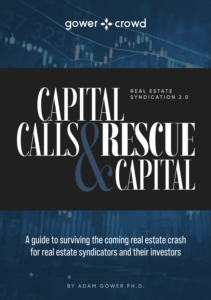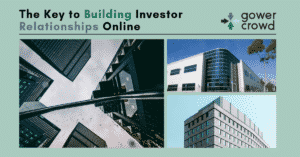The Ultimate Guide to SEO for Real Estate Developers
By Adam Gower Ph.D.

As many as 93% of all online experiences start with a search engine. Why does that matter to you? If you’re not optimizing your website and the content on it using an SEO strategy, you could be missing out on a huge number of leads.
Search Engine Optimization (SEO) Basics
What is SEO? The long form is “search engine optimization”. In its most basic definition, SEO is the practice of making specific changes to your website to help it appear in search engine (think Google) results pages. What you’re doing is making your website cater to both the people visiting it and the search engines themselves, in an effort to get more visibility in search engine results pages.
It sounds like something only tech brands and online businesses would care about, but it’s relevant to every single company that has a website, even real estate developers. Today’s investors use search engines and the internet in general to help them find opportunities.
If you’re not prominently displayed where they’re looking, you could miss out on a whole market of investors.
More importantly, by showing up in their search results when your prospects are looking online for information about real estate investing, you are appearing at the ‘moment of maximum intent,’ which makes these folk your hottest leads.
The purpose of SEO is to get as high on the search results as possible. You want to be in the first page of results, as close to the top as possible, ideally within the top 3. The first page results catch anywhere between 67% - 95% of ALL traffic. If you’re not there, you might as well not exist in the eyes of searchers!
Starting SEO takes time, but the results are often worth the efforts. Get familiar with SEO, learn the basics, and get started now before you miss out on new leads.
Let’s start at the beginning.
Get access to our FREE weekly newsletter exclusively covering the latest updates from the real estate crowdfunding world
On-Page Vs. On-site SEO
SEO comes into play in every part of your website, from the words written on each page to the source codes in the background and beyond. To help you understand how it’s organized, SEO is broken down into two broad categories: on-page SEO and on-site SEO.
Let’s take a look at what these terms mean and how they play into optimization.
On-Page SEO
On-page SEO is the category you hear about most often. It deals with everything you encounter on your individual content pages. This includes things like the structure of the content, the layout, media used, and your word choices.
Most people focus a lot of attention on getting their on-page SEO right. It’s an important part of your overall strategy because it helps lead people to individual content pages on your site. Without proper on-page SEO, it’s difficult to get your content on top of the search results.
On-Site SEO
The other side of the equation is on-site SEO. Instead of focusing on what’s happening on an individual page of your website, on-site SEO deals with the wider picture of your whole site. While on-page deals mostly with front-end, visible details, on-site handles the back end and the more technical side.
When dealing with the back end, you’re handling internal/external linking, site maps, SSL certificates, and overall site structuring. It’s more difficult to do on-site SEO, but it’s just as vital to success as on-page SEO. Because it’s often more technical, this side of SEO tends to be outsourced.

SEO Core Concepts
To understand SEO, you need a little background on some of the individual pieces that affect search engine results. This list is some of the core elements that have been part of SEO for years. With every search engine update, the impact of these elements and how they’re used to determine search results can vary. However, each of these core parts of SEO have been consistently important for years.
1. Keywords
Keywords are topical words or short phrases that guide the results when search terms are typed into search engines. When a term like “multi-family development” or “real estate crowdfunding” is searched, you expect results to appear that are relevant to that term. If you type in a question, like “what was the first syndicated real estate deal?”, you expect to get an answer that’s specifically related to your question.
At the very beginning, keywords were the most important and sometimes the only factor that played into search engine results. Google and other search engines began indexing and cataloging the internet based first on keywords.
Once this was discovered, people began to manipulate the system by stuffing keywords into their site content, whether they were relevant or not. This turned into a huge mess of unreadable content often unrelated to search terms.
Today, keywords are still important, but they’re part of a more balanced mix. You need keywords to help search engines understand what your content is about and what topics it’s related to. Without solid keywords, it will be difficult for search engines to show your content in the most relevant results pages. But the content has to be readable and useful above all.
2. Linking
Linking is the practice of creating hyperlinks on text within your website content. Links can be placed on any amount of text, but usually occupy a word or short phrase related to wherever the link leads. You can and should do both internal linking and external linking.
Internal linking is creating links to other places within your website. You’re helping to point viewers to other content or pages within the same site. This is a useful practice for two reasons. First, it can help keep people on your site for longer by leading them to other relevant content they might want to see. Second, it helps search engines explore your site and understand how your website is structured, which makes it easier to index your pages.
External linking is putting in links that lead to outside websites. You can link to any website in existence, though you want to be careful in practice. Search engines might associate your website with the pages you’re linking out to.
This is good if you’re linking to legitimate sources that serve as authorities in the industry, but it’s bad if you’re linking out to untrustworthy sources or broken links.
Linking happens both inside your website and outside of it, meaning that while you want to be linking to external sources, having external sites links to you is a key part of good SEO. When an external site points to your site, this is called a backlink and an important part of building up the authority of your site and improving your ranking is generating quality backlinks to your site and content. When outside sources link to you, they’re creating a link between their content and yours. You can break links you don’t want, but in general it’s good to have more backlinks, especially if they come from reputable, trustworthy places.
Quick note: website authority is the presumed trustworthiness of a website based on their reputation and expertise. For example, a government web page is presumed to have more authority than Wikipedia or a new, unknown blog.

3. Content Structuring
The structure of your content is tied to on-page and on-site SEO practices. Dealing with on-page SEO, structure refers to how your page is organized, what text pops up in the search results, and how easily a search engine crawling bot can read your content for indexing. Crawlers are the programs designed by search engines that visit and explore every website on the internet, in order to index it so it can appear in search results.
Your content must be both readable by human visitors and crawlable for search engines. Readability for humans is easy, as it’s all about making things aesthetically pleasant and avoiding bad writing (large walls of unbroken text, no separation in the text, poor use of grammar or punctuation, etc.). Crawlability is a little more specific.
Crawler bots cannot understand the structure of a page’s content unless you show it to them through various clues hidden within your formatting and surface-level coding. The most common ways you’ll do this is through headings and search result text editing.

H2 headings are built into the text to break up paragraphs and signify what’s contained within each section of text. There are H3s, H4s, and others, but they’re not as commonly used.
For an example of headings, look at the way this page, the one you are now reading, is structured. At the top you have the title/H1 heading, followed by sections of text with a H2 heading above them. The H2 heading for this particular section is “SEO Core Concepts”. There are H3 headings in the previous section, “on-page SEO” and “on-site SEO”.
You can’t normally edit the text that displays on search engine results pages unless you have a plug-in or program to help you edit the code directly. It’s easy to get a program that will allow you to do these edits, and it can help your site show up in a more orderly way. You can change the SEO title that appears on search engines as well as the short description under your title.
Content structuring is complex. This is a short introduction to get you a little more familiar with it, but there’s a lot to learn if you want to do it well on your own site.
Get access to our FREE weekly newsletter exclusively covering the latest updates from the real estate crowdfunding world
4. Bounce Rate
The bounce rate for your site and pages ties in with making your content readable for human audiences. If people find your site when they search for a specific term, search engines track how long they stay on your site. When people leave too quickly after clicking on a search result, that’s considered “bouncing”. It’s usually a signifier that either the content was irrelevant for their search or the content was not easily readable.
Improving your bounce rate is vital to keeping your site on top. If you get a high bounce rate, you’re likely to lose ranking over time.
5. Niching
The practice of niching out your content is focusing your efforts on attracting only the types of people you really want as your customers. While you could put in the work to draw as many people to your site and content as possible, you might be wasting time if these aren’t the kinds of people that are likely to become your investors.
Niching means defining your company, real estate asset class, and value proposition and deciding who your ideal investor is. You’ll dedicate your SEO efforts and content marketing towards attracting those people. Instead of casting a wide net, you’re specifically targeting the most valuable views.
In real estate development, this could mean narrowing your focus from “development” to “CRE development” or further to “retail development”.

Monitoring SEO
It’s good to know what affects your search engine ranking, but how do measure your results? You can pay attention to the bits of information that search engines let you see. While they conceal the exact data about certain key searching factors to avoid manipulation, they do allow you to gain some insights.
Looking at your overall traffic is useful, as rises or falls can point to success or mistakes. Observe traffic through the lens of bounce rate, as this will give you some clues to whether people are staying and viewing your content or leaving right away.
The number of keywords you have indexed from your specific pages is a good indication of how crawlable and relevant your site is. Going along with this, you want to look at your ranking for your target keywords. If you’re ranking well for your highest priority keywords, that’s a good sign. Ranking poorly for those keywords isn’t always bad, if you’re ranking well enough for other relevant keywords instead.
You also want to look at how many backlinks you have to your site in general and your content pages specifically. Having more backlinks is usually better, unless those links come from bad sources. If they come from good, authoritative sources, higher numbers of backlinks is a great sign that your content is useful and relevant to the industry.
The Payoff from Doing SEO Well
What’s the whole point of SEO? While it seems like a lot of work for a little reward, your position in search results pages can determine how easy you are to find, and it can lead to an enormous boost in visitors to your website. Once you get to that point, it’s up to you to turn those visitors into leads, who you can then work to convert into investors or customers.
SEO is a long-term strategy. There are no shortcuts to instant success. If you work at it consistently and keep up a solid SEO strategy, you’ll start seeing the results within 6 – 12 months. Once you’ve laid the groundwork for good SEO, it’s easy to keep it going and see better results every year. Getting started is often the hardest part, but don’t let that stop you!
If you have only just started in real estate development, have completed no deals, have no email list, but know you want the freedom and wealth being a real estate developer brings, then I suggest your first step is to start evaluating deals so you can recognize a good one when you see it.
Here’s where you should start. You’ll learn everything you need to know – the different types of real estate, different development strategies, how real estate cycles influence the market, and all about due diligence.
If you want to find deals and raise money for them so you can start your real estate development business, then learning how to conduct due diligence so you can pitch your deals better to investors is a great place to start.
If you’ve already purchased one or more real estate project and are seeing more opportunities than you can finance, then now is the time to start building your investor network so you can finance all your next deals quicker.
You’ve already got some momentum; now start finding and educating prospects about what you’re doing so you can build an email list of people to pitch to when you’re ready to raise money for your next deal.
This is what we build for private clients all the time – it’s called the Investor Acquisition System and you can access the entire program right here so you can find prospects, and convert them into being deep pocketed, repeat investors in your deals.
If you are a seasoned pro with multi-cycle experience, a substantial portfolio, a decent deal pipeline, and find yourself spending too much time raising equity capital because you’re still doing it in-person, then it’s time you put technology to work for you.
The wonderful thing about doing this is that you’re not going to be doing anything different than you’re already doing and, guess what, you’ll never have to sit through investor meetings again.
Sounds crazy I know, but I lay the whole thing out for you in this white board workshop where I personally show you exactly what it takes for you to transform your equity raising into a fully automated, capital raising machine so you can find new investors while increasing commitments from your existing network.






